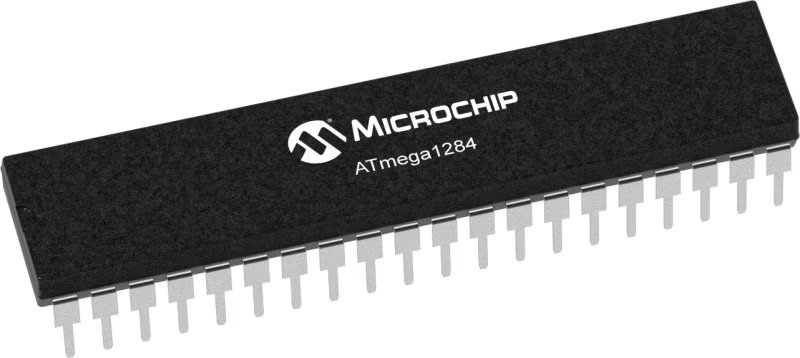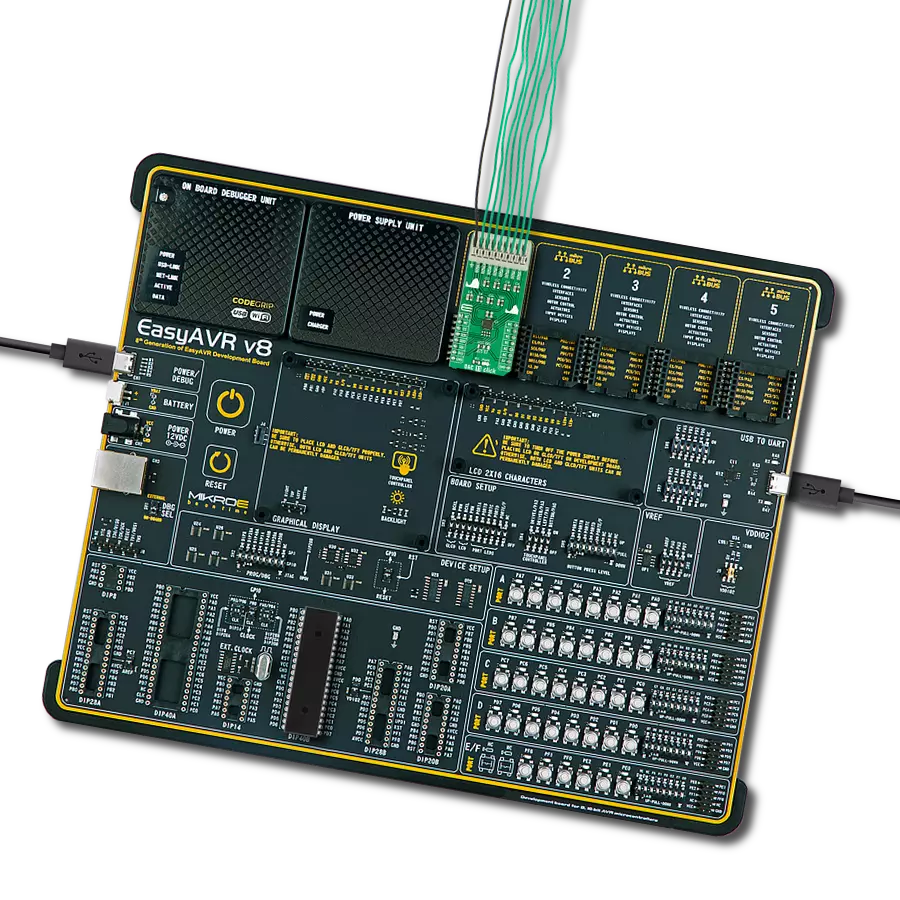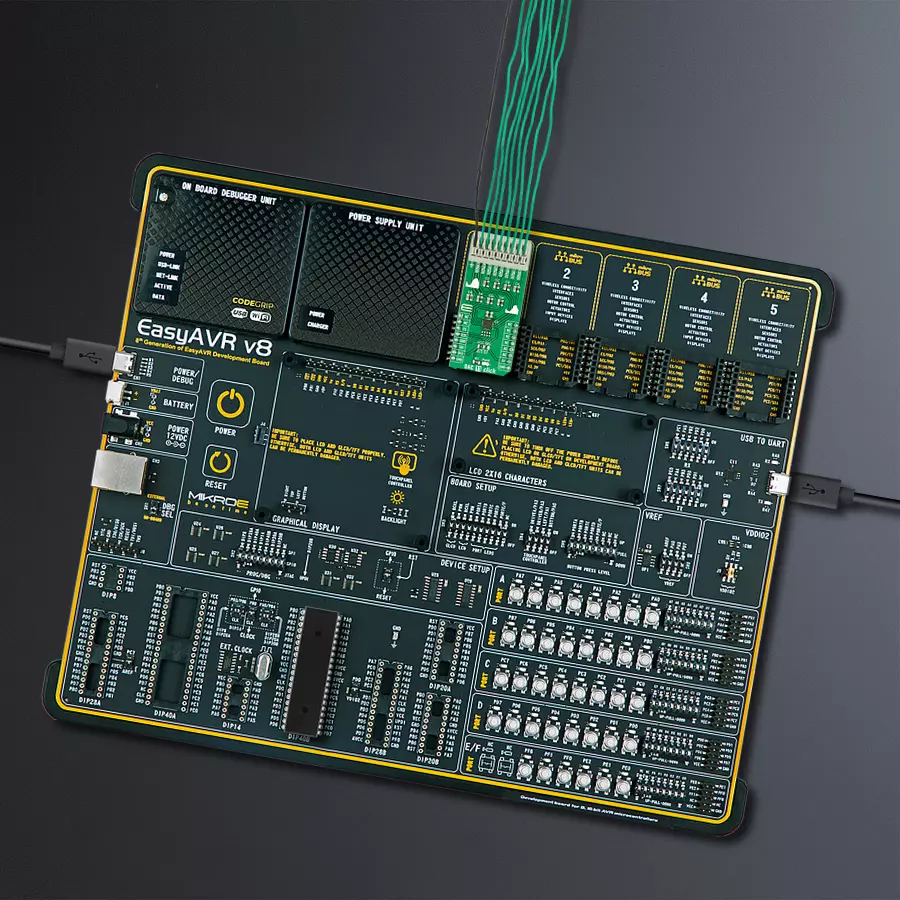From sensors to control circuits, this solution bridges the gap between digital data and analog actions, enhancing your ability to drive insights
A
A
Hardware Overview
How does it work?
DAC 11 Click is based on the DAC128S085, a general-purpose 12-bit 8-channel digital-to-analog converter (DAC) from Texas Instruments. The DAC128S085 is fabricated on a CMOS process with an architecture that consists of switches and resistor strings followed by an output buffer. It ensures monotonicity, low power consumption of 4.85mW at 5V, individual channel power-down capability, and has high precision output amplifier that allows rail-to-rail output swing over a wide supply voltage range. DAC architecture consists of 4096 equal-valued resistors with a switch at each junction of two resistors, plus a switch to ground. The code loaded into the DAC register determines
which switch is closed, connecting the right node to the amplifier. Because all eight channels of the DAC128S085 can be controlled independently, each consists of a DAC register and a 12-bit DAC. Depending on the mode of operation, data written into a DAC register causes the 12-bit DAC output to be updated, or an additional command is required to update the DAC output. Also, a Power-On reset circuit ensures that the DAC outputs power up to zero volts and remains there until there is a valid write to the device. The DAC 11 Click communicates with MCU using the SPI serial interface compatible with standard QSPI, MICROWIRE, and DSP interfaces, with a maximum
frequency of 50 MHz. Also, this Click board™ is designed to utilize the entire dynamic range of DAC128S085 by having all power supply pins (and reference voltage pins) connected, sharing the same supply voltage. In addition, the user can further use the RC filter at the output to roll off output noise. This Click board™ can operate with either 3.3V or 5V logic voltage levels selected via the VCC SEL jumper. This way, both 3.3V and 5V capable MCUs can use the communication lines properly. Also, this Click board™ comes equipped with a library containing easy-to-use functions and an example code that can be used, as a reference, for further development.
Features overview
Development board
EasyAVR v8 is a development board designed to rapidly develop embedded applications based on 8-bit AVR microcontrollers (MCUs). Redesigned from the ground up, EasyAVR v8 offers a familiar set of standard features, as well as some new and unique features standard for the 8th generation of development boards: programming and debugging over the WiFi network, connectivity provided by USB-C connectors, support for a wide range of different MCUs, and more. The development board is designed so that the developer has everything that might be needed for the application development, following the Swiss Army knife concept: a highly advanced programmer/debugger module, a reliable power supply module, and a USB-UART connectivity option. EasyAVR v8 board offers several different DIP sockets, covering a wide range of 8-bit AVR MCUs, from the smallest
AVR MCU devices with only eight pins, all the way up to 40-pin "giants". The development board supports the well-established mikroBUS™ connectivity standard, offering five mikroBUS™ sockets, allowing access to a huge base of Click boards™. EasyAVR v8 offers two display options, allowing even the basic 8-bit AVR MCU devices to utilize them and display graphical or textual content. One of them is the 1x20 graphical display connector, compatible with the familiar Graphical Liquid Crystal Display (GLCD) based on the KS108 (or compatible) display driver, and EasyTFT board that contains TFT Color Display MI0283QT-9A, which is driven by ILI9341 display controller, capable of showing advanced graphical content. The other option is the 2x16 character LCD module, a four-bit display module with an embedded character-based display controller. It
requires minimal processing power from the host MCU for its operation. There is a wide range of useful interactive options at the disposal: high-quality buttons with selectable press levels, LEDs, pull-up/pulldown DIP switches, and more. All these features are packed on a single development board, which uses innovative manufacturing technologies, delivering a fluid and immersive working experience. The EasyAVR v8 development board is also integral to the MIKROE rapid development ecosystem. Natively supported by the MIKROE Software toolchain, backed up by hundreds of different Click board™ designs with their number growing daily, it covers many different prototyping and development aspects, thus saving precious development time.
Microcontroller Overview
MCU Card / MCU

Architecture
AVR
MCU Memory (KB)
128
Silicon Vendor
Microchip
Pin count
40
RAM (Bytes)
16384
Used MCU Pins
mikroBUS™ mapper
Take a closer look
Click board™ Schematic

Step by step
Project assembly
Track your results in real time
Application Output
1. Application Output - In Debug mode, the 'Application Output' window enables real-time data monitoring, offering direct insight into execution results. Ensure proper data display by configuring the environment correctly using the provided tutorial.

2. UART Terminal - Use the UART Terminal to monitor data transmission via a USB to UART converter, allowing direct communication between the Click board™ and your development system. Configure the baud rate and other serial settings according to your project's requirements to ensure proper functionality. For step-by-step setup instructions, refer to the provided tutorial.

3. Plot Output - The Plot feature offers a powerful way to visualize real-time sensor data, enabling trend analysis, debugging, and comparison of multiple data points. To set it up correctly, follow the provided tutorial, which includes a step-by-step example of using the Plot feature to display Click board™ readings. To use the Plot feature in your code, use the function: plot(*insert_graph_name*, variable_name);. This is a general format, and it is up to the user to replace 'insert_graph_name' with the actual graph name and 'variable_name' with the parameter to be displayed.

Software Support
Library Description
This library contains API for DAC 11 Click driver.
Key functions:
dac11_write_control_reg- This function writes data to a single control register by using SPI serial interfacedac11_set_all_ch_voltage- This function sets the output voltage of all channels depending on the vref valuedac11_set_specific_ch_voltage- This function sets the output voltage of the specific channels depending on the vref value
Open Source
Code example
The complete application code and a ready-to-use project are available through the NECTO Studio Package Manager for direct installation in the NECTO Studio. The application code can also be found on the MIKROE GitHub account.
/*!
* @file main.c
* @brief DAC11 Click example
*
* # Description
* This example demonstrates the use of DAC 11 Click board.
*
* The demo application is composed of two sections :
*
* ## Application Init
* Initializes the driver and executes the Click default configuration which sets the WRM mode and
* disables all outputs.
*
* ## Application Task
* Changes the output voltage of all channels every 2 seconds and logs the voltage value on the USB UART.
* It will go through the entire voltage range taking into account the number of steps which is defined below.
*
* @note
* Measure the voltage at VCC_SEL jumper and adjust the reference voltage value below for better accuracy.
*
* @author Stefan Filipovic
*
*/
#include "board.h"
#include "log.h"
#include "dac11.h"
#define REFERENCE_VOLTAGE 3.3 // The reference voltage defined by the VCC_SEL on-board jumper.
#define NUMBER_OF_STEPS 20 // The number of steps by which we will divide the entire voltage range.
static dac11_t dac11;
static log_t logger;
void application_init ( void )
{
log_cfg_t log_cfg; /**< Logger config object. */
dac11_cfg_t dac11_cfg; /**< Click config object. */
/**
* Logger initialization.
* Default baud rate: 115200
* Default log level: LOG_LEVEL_DEBUG
* @note If USB_UART_RX and USB_UART_TX
* are defined as HAL_PIN_NC, you will
* need to define them manually for log to work.
* See @b LOG_MAP_USB_UART macro definition for detailed explanation.
*/
LOG_MAP_USB_UART( log_cfg );
log_init( &logger, &log_cfg );
Delay_ms ( 100 );
log_info( &logger, " Application Init " );
// Click initialization.
dac11_cfg_setup( &dac11_cfg );
DAC11_MAP_MIKROBUS( dac11_cfg, MIKROBUS_1 );
err_t init_flag = dac11_init( &dac11, &dac11_cfg );
if ( SPI_MASTER_ERROR == init_flag )
{
log_error( &logger, " Application Init Error. " );
log_info( &logger, " Please, run program again... " );
for ( ; ; );
}
dac11_default_cfg ( &dac11 );
log_info( &logger, " Application Task " );
}
void application_task ( void )
{
float step = REFERENCE_VOLTAGE / NUMBER_OF_STEPS;
float output_voltage = step;
uint8_t cnt = 0;
while ( cnt < NUMBER_OF_STEPS )
{
dac11_set_all_ch_voltage ( &dac11, REFERENCE_VOLTAGE, output_voltage );
log_printf( &logger, " All channels output voltage set to %.2f V\r\n", output_voltage );
output_voltage += step;
cnt++;
Delay_ms ( 1000 );
Delay_ms ( 1000 );
}
}
int main ( void )
{
/* Do not remove this line or clock might not be set correctly. */
#ifdef PREINIT_SUPPORTED
preinit();
#endif
application_init( );
for ( ; ; )
{
application_task( );
}
return 0;
}
// ------------------------------------------------------------------------ END


































